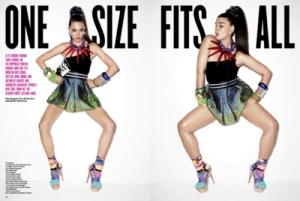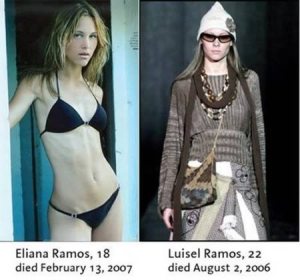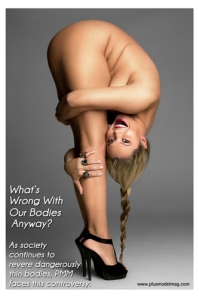The fashion industry has always had an impact on its consumers, especially women. It’s no surprise they strive to look beautiful by imitating the models they are surrounded with each day. They see them on billboards when driving to work, on the television when they get home and relax, when checking their e-mail inbox on ads in websites and right before they go to bed when reading a magazine. It’s a fact that current models don’t represent the average woman. Average women are between sizes 12 and 16 and fashion models normally have to be within sizes 0 to 3 in order to be successful, many of which admit to not having a healthy diet and getting through the day with only Diet Coke and lettuce. Twenty years ago the average fashion model weighed 8% less than the average woman. Today, she weighs 23% less. Unfortunately, the misrepresentation of women will continue to be a part of the fashion industry unless those running it change their preference with models.
Those in charge of this industry are fashion designers and booking agents. They are the ones who handpick models for their runway shows, commercials and fashion spreads. In the 1950’s, women with a defined hourglass shape were favored. Marilyn Monroe, Brigitte Bardot and Raquel Welch had the body women wanted to have and men wanted to touch. The 1960’s came along with Twiggy, the English model known worldwide for her boyish build and curveless body. Some blame her for changing the face of fashion but recently, she commented against skinny models saying that her weight was natural and not forced by the diets current models get into. Twiggy gained international fame when she was just a teen, another reason why her body looked the way it did. She was not fully developed. Nowadays, designers still hire teens to model in their shows because of this. In the 1980’s the fashion world was ruled by Naiomi Campbell, Tyra Banks and Cindy Crawford. Oddly enough, these women were the size that today is considered plus. Ten years ago plus-size models averaged between size 12 and 18. Today the need for diversity within the plus-size modeling industry continues to be questioned. The majority of plus-size models on agency boards are between a size 6 and 14, while costumers continue to express their dissatisfaction. Even though it seems as if most people are in favor of having models with a healthy weigh sell a product, many don’t believe this is something that should become a reality.
 Raquel Welch
Raquel Welch
Italian researchers, Dr. Luca Savorelli and Dr. David Dragone from the University of Bologna have concluded that putting women bigger than a size 8 on the catwalk sends a message to the obese people of the world that it’s ok to be fat. According to them, “To promote chubby fashion models when obesity is one of the major problems of industrialized countries seems to be a paradox… Given that in the US and Europe people are on average overweight, we conclude that these policies, even when they are welfare improving, may foster the obesity epidemic.” They claim that if we are surrounded by images of people who look heavier, it “induces people to become more overweight,” and thus impairs our health. They warn that this trend will only worsen the “obesity epidemic.”
Obviously, putting more realistic women on the catwalk will not make overweight people feel good about being overweight. Fashion Designers would make a huge step in the right direction by choosing larger models for their runway shows and by larger, I mean having a healthy weight and more meat on their bones. I’m not sure why Savorelli and Dragone were concerned about this issue since there hasn’t been a dramatic increase in overweight models coinciding with a spike in the world’s obesity rates. In fact, models are thinner than ever and obesity rates are the highest they’ve ever been.
It is said that another reason why plus-size models are shunned is that they tend to be overly sexy in ad campaigns and take the focus off of the product they are supposed to be selling. All of a sudden the pages in a magazine are not a fashion spread anymore and it becomes a modeling portfolio. Instead of the model being a real life hanger for the dress she is modeling, her curves stick out. In other words, she is wearing the dress and the dress is not wearing her.

Plus size model, Crystal Renn
Over the years, we have learned that sex sells. I’m not the only one that believes that using a curvy model to sell a dress might boost a designer’s sales. It is scientifically proven that men and women find models with a waist to hip ratio of at least 0.7 more attractive than those who don’t have a defined waist. Naturally, they will stop and stare at a page in a magazine as their eyes start following the silhouette of a curvy model. Also, most women in today’s society have curves and will relate to plus-size models, making them more likely to purchase confidently whatever the model has on knowing it will look similar on them.
Many blame the economic crisis on the continuous shrinking size of models and see it as a necessity. It is not a coincidence that the thinnest models are used for Haute Couture fashion shows. Haute couture is made to order for a specific person, it is usually made from high-quality, expensive fabric and sewn with extreme attention to detail and finished by the most experienced and capable seamstresses, often using time-consuming, hand-executed techniques. Haute Couture shows always showcase elaborate gowns that normally wouldn’t be worn in everyday life. These can range from a light work suit made from newspaper to a 40 pound diamond covered dress. An haute couture garment is made specifically for the wearer’s measurements and body stance. Having in mind how expensive they are to make, designers save themselves a lot of dollars by using the world’s thinnest models as canvases.

Haute Couture
While many people consider haute couture an art form, others don’t support it. It is the goal of many models to walk the runway while wearing an haute couture creation and they know they have to shrink their size in order to make this dream a reality. Although it wasn’t an haute couture show, Luisel Ramos, a 22 year-old Uruguayan model, died of heart failure caused by anorexia nervosa right after modeling in a fashion show during Fashion Week in Montevideo, Uruguay. It is said that she had gone several days without eating in order to “prepare” for the show. Also, she had adopted the Diet Coke and lettuce diet 3 months before. At the time of her death, she had a body mass index of 14.5 which the World Health Organization considers to be starvation. Six months after her death, her sister, Eliana Ramos, died of a heart attack due to malnutrition. She was also a model and she was only 18. Since the year 2000, at least 4 models have been reported to have died due to anorexia nervosa and 14 have committed suicide while still being an active model because of the pressure to be thin.
Right after the sister’s deaths, Madrid Fashion Week set a minimum body mass index of 18 for all models and Italian fashion designers banned size 0 models from walking down their catwalks. Although this is an improvement, it is not enough.

Current models still set a wrong example for women by not having a healthy body image and they continue to deteriorate their health. Unfortunately, “thin is in” and it will be for a long time. Women’s perception of beauty will change as soon as they find themselves bombarded with advertisements presenting a model that has a body similar to theirs and is happy with it knowing they are not at risk of losing their job as models just because their ribs can’t be visually counted.
Apparently, the fashion industry is holding onto the unproven theory that plus-size models will make us overweight. What many people don’t know is that it’s possible to be healthy at many different sizes and shapes, and it’s their own internal bias that prevent them from considering that a larger person could be healthier than a smaller one. Studies show that most health indicators, such as blood pressure and insulin sensitivity can be improved through changing health behaviors, even if they don’t lose weight. When consumers realize that they’re being brainwashed into thinking they don’t fit the norm, and decide to not support fashion designers who feed them this idea, we will finally see a change in the fashion industry and the average woman will actually be inspired to accept herself as she is while models are allowed to look like a healthy human being.








